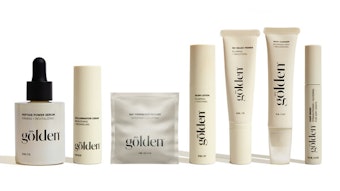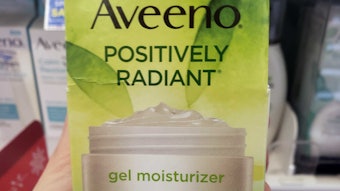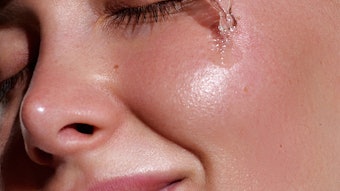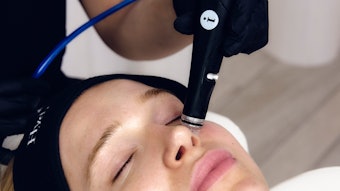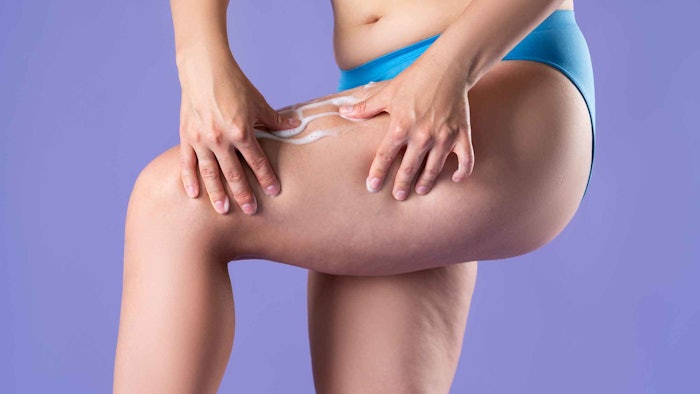
Body care has boomed as consumers are finally treating the skin on their bodies as they do the skin on their faces. The market demands healthy, well-nourished, firm and toned skin, and brands have responded with products to address every skin concern; including sun protection, cellulite, wrinkles and stretch marks, to name a few.
Log in to view the full article
Body care has boomed as consumers are finally treating the skin on their bodies as they do the skin on their faces. The market demands healthy, well-nourished, firm and toned skin, and brands have responded with products to address every skin concern; including sun protection, cellulite, wrinkles and stretch marks, to name a few.
Products that exfoliate and plump the top layer of skin, as well as those that repair on a cellular level for a tighter, smoother look, have become part of the structured body skin care routine.1 Such offerings continue to advance as research progresses toward understanding skin, the factors that damage it and how these effects can be reversed through multiple pathways.2
Skin tightening products, in particular, are projected to expand at a CAGR of 11.7% from 2023 to 2030.3 The claim for skin firming covers wide-ranging concerns such as sagging, cellulite, crepiness and stretch marks. As such, the products available on the market may address any of these concerns with some overlapping benefits; though most are not formulated to treat them all.
This article reviews the factors causing skin wrinkling and sagging and explores pathways to counteract multiple concerns to firm and tighten skin. It also describes combinations of ingredients to impart the desired benefits.
Causes of Skin Wrinkling and Sagging
With aging, the body undergoes sequential changes in response to various internal and external factors.1 Internal factors such as cellular metabolism and hormonal changes cause natural age-induced alterations in skin, whereas external factors, including pollutants, chemicals, UV and blue light radiation, lifestyle, etc., can cause premature aging, affecting epidermal thickness and the morphology of deeper tissues.1, 4 As the body continues to adapt, changes begin on a cellular level that ultimately impact the function, shape, consistency and appearance of tissues and organs.1
Skin generally begins as smooth and nourished but aging progressively marks the formation of an “orange peel” appearance, wrinkles and tissue sagging.1, 5 Example structure and function changes that occur in skin with age include:1, 2, 4
- The biological aging of cells, decreasing the skin’s ability to repair itself;
- A decrease in the production of collagen and elastin, which give skin its strength and elasticity;
- A diminished capacity to retain water due to the steady deterioration of skin’s structure and function; and
- A decrease in the number of melanocytes – cells that produce the melanin pigment and give skin its color.
Studies have also shown the formation of wrinkles and sagging occurs due to the reduced expression of both collagen type VII and depleted fibrillin. In addition, sun exposure further impairs the quality of skin by causing solar elastosis – an accumulation of abnormal elastic fibers that deteriorates collagen type I content. Indeed, photodamaged tissues have deeper wrinkles, rough and fragile skin, and irregular pigmentation, whereas sun protected aged skin shows fine wrinkles, a loss of elasticity, dryness and reduced thickness.1, 4, 5
Weight gain can be another factor in sagging and wrinkles, as it can cause the collagen and elastin fibers in body skin to stretch, which weakens and damages them. This includes during pregnancy, when the skin around abdomen stretches to accommodate the growth of a baby, which can leave excess and loose skin.6
If a considerable amount of extra weight is carried for a period of time, this hinders the skin’s ability to bounce back to its original state.6 Unfortunately, weight loss doesn’t offer a solution, as the fibers lose their ability to retract; in fact, quick weight loss results in saggy skin.
A few medical conditions may also result in wrinkled and sagging skin. Rare connective tissue disorders such as Ehlers-Danlos syndrome, or disorders such as cutis laxa and wrinkly skin syndrome are examples.6 These factors accelerate and contribute to the loss of skin integrity in multiple ways.2
Taken together, aging, a detrimental lifestyle, environmental exposure and medical conditions are all starting points of unstoppable and degenerative processes in skin that occur at different speeds. Considering these multifaceted causes of wrinkling and sagging, solutions to address them require different mechanisms of action that take diverse pathways to counteract both biological and environmental factors. Such pathways are described next.
Courses of Action for Skin Firming and Tightening
Several courses of action and their combinations have been explored to achieve firming, smoothing and tightening effects and cohesive results for repaired, renewed and replenished skin.2 Six main approaches include the following.
1. Stimulating collagen synthesis: Perhaps the most important mechanism of action to address wrinkled and sagging skin is the stimulation of collagen synthesis. The amino acids glycine and proline work as precursors to convert procollagen to collagen and induce changes in polypeptide chains to build the triple helix structure that supports the skin’s ability to defend and regenerate itself.7
2. Contracting collagen and protecting elastin fibers: An additional supply of hydroxyproline, proline and collagen to skin through products based, e.g., on liposomal delivery systems can help to contract collagen fibers and protect elastin fibers. Hydroxyproline increases elasticity whereas proline decreases elasticity to provide stiffness and structure to the skin matrix. This helps to balance the deprivation of collagen with age and revitalizes skin from its core.7
3. Modulating genes affecting skin aging: Regulating the genes responsible for aging is another approach to help achieve firm and toned skin. For example, those encoding for Collagen I, Collagen III and Collagen IV can impart strength, integrity and structural support to skin. Others, targeting fibrillin, fibronectin and versican, improve tissue cohesion, which results in firmness, elasticity and tonicity. Another is HAS2, which relates to wrinkle smoothing. These genes can revive collagen and DEJ production.8
4. Free radical scavenging: Free radical scavengers work both by preventing the formation of reactive oxygen species and by eliminating them before they can damage skin cells, thereby protecting skin and preserving its structure.9
5. Protecting the epidermal barrier: Skin barrier products with combinations of ceramides, cholesterol and fatty acids can replenish damaged skin, preserving this highly cohesive, multilayer cell structure that works as an innate defense system against physical, chemical and microbial aggressions.10
6. Inhibiting skin-aging enzymes: Finally, inhibiting or reducing anti-collagenase, anti-elastase and anti-tyrosinase activity can slow the processes of skin aging. Various plant actives have been found to inhibit such enzymes while additionally providing strong antioxidant effects.11
Anti-aging and Anti-sagging Ingredients
As with any formula, the right combinations of ingredients for specific skin concerns integrated with new formulation techniques and delivery systems is crucial to create effective products. Some combinations of such are explored here.
Ceramide and collagen: Different types of ceramides work differently in skin; for example, Ceramide III reinforces the skin’s barrier while Ceramide IIIB supports skin renewal. Therefore, barrier protection creams with complexes of ceramide, cholesterol and fatty acids improve the natural protective lipid layer and form an effective, healthy and damage-free barrier.5, 12
Vegan marine inspired collagen with demonstrated benefits of skin moisturization and protection is another option for skin barrier enhancement. And as mentioned previously, the combination of elastin and collagen creates a rich bioactive formula that can maintain the skin’s integrity, even after being stretched.5, 7
Vitamins, co-enzyme Q10 (CoQ10) and polysaccharides: Retinol is considered the gold standard of anti-aging skin care, as it is a vitamin that helps to thicken the skin and prevent it from becoming thinner and weaker.7 Vitamin C is a potent antioxidant that can transform lackluster skin, giving it a smooth and glowing appearance. Such vitamins in nanoparticle form, with an average size greater than 200 nm, can be encapsulated to facilitate additional advantages; e.g., allowing formulators to play with textures and product forms while maintaining good efficacy.
Antioxidants like vitamin C and CoQ10 that fight free radical damage to prevent inflammation can be paired for peak effectiveness.10 Furthermore, vegetal polysaccharides can be included to instantly erase fine lines and leave skin visibly smooth and cushioned all day long.
Emollients and SPF: Emollients have become much more sophisticated with the addition of chemicals designed to not only prevent water evaporation, but also to draw more fluid in from the dermis to hydrate the epidermis. Some emollients also facilitate the penetration of active ingredients to firm, regenerate and balance skin.5, 12
In addition, the application of sunscreen is a non-negotiable step in the body care routine. Mineral sunscreen agents titanium dioxide and zinc oxide, in their nano or dispersed form, offer low or no whitecast with good sensorial feel and efficacy.9
Humectants, amino acids and colloidal goal/platinum: Hyaluronic acid, sugar derived complexes of xylitol and anhydrous xylitol and vegetable glycerin do more than simply hydrate the skin. They optimize the skin’s flow to reserve and maintain moisturization for longer hours.5
Amino acids such as dipalmitoyl hydroxyproline promote collagen synthesis and enhance skin tone. This ingredient is also an excellent moisturizer and functions as an antioxidant.13, 14 Such multifunctional age-defying peptides play a key role to reverse skin fatigue by fortifying skin tonicity and elasticity. In relation, the premium concept of gold and platinum peptides leverage colloidal gold and platinum as a carrier and to form a protective shield for ingredients such as acetyl heptapeptide-9 peptide and acetyl tetrapeptide-17.10
Plant oils and extracts: Plant oils and extracts have long served as an important source of bioactive compounds for cosmetics and new research is using them to design novel preventive and effective strategies. Polyphenols and triterpenes, for example, enhance dermo-epidermal cohesion to reduce flaccidity. Green tea, centella, ginseng, white truffle, grapefruit, goji berry, coffee and bamboo extracts are a few more promising wrinkle-correcting, moisturizing and anti-inflammatory plant actives.
AHA, BHA and PHA: Alpha, beta and poly hydroxy acids (AHAs, BHAs and PHAs) have the ability to reduce the cohesion of dead corneocytes to skin, giving skin a smoother, less wrinkled and less orange-peel appearance. AHAs are making a dramatic entry into peeling, anti-aging and clarifying products. Glycolic acid and lactic acid are two of the most common AHAs, whose efficacy is determined by their pH and concentration.
The most common BHA is salicylic acid, whereas PHAs include gluconolactone and lactobionic acid. PHAs are structurally larger molecules than AHAs and they exhibit slower penetration – which makes them potentially less irritating and sensitizing to the skin. They also add moisture to the skin and can be combined with anti-wrinkle actives.10
Conclusion
It is natural for the skin’s density and elasticity to decline with age, in addition to factors related to gender, ethnic background, lifestyle and weight. Solutions therefore must be designed to address multiple concerns, bearing in mind that firming and tightening results may vary from person to person and based on the severity of the skin condition. To bring clarity for consumers, it is also important to use specific terms and claims for given skin concerns.
Furthermore, skin health and safety should be a primary concern for formulators with respect to the selection of each ingredient, as these will work together on a cellular level. An understanding of the bioavailability of each ingredient is essential as well, to ensure efficacy.
Additional studies on the effects of delivery systems for given actives could improve the efficacy of products. Finally, consumer insights will support formulation design to either address specific, customized concerns or represent the wide scope of body skin care.
References
1. Pensalfini, M., Rotach, M., … Mazza, E., et al. (2020 Oct). How cosmetic tightening products modulate the biomechanics and morphology of human skin. Acta Biomaterialia. Available at https://www.sciencedirect.com/science/article/pii/S1742706120304876
2. Farage, M.A., Miller, K.W., Elsner, P. and Maibach, H.I. (2013 Feb). Characteristics of the aging skin. Advances in Wound Care. Available at https://www.ncbi.nlm.nih.gov/pmc/articles/PMC3840548/
3. Grand View Research. (Accessed 2023, Oct 3). Skin tightening products market size, share and trends analysis report by product, by application (anti-aging, face lifting), by distribution channel, by region and segment forecasts, 2023 – 2030. Available at https://www.grandviewresearch.com/industry-analysis/skin-tightening-products-market-report
4. Bonté, F., Girard, D., Archambault, J.-C. and Desmoulière, A. (2019). Skin changes during aging. Subcell Biochem. Available at https://pubmed.ncbi.nlm.nih.gov/30888656/
5. Lefèvre-Utile, A., Braun, C., Haftek, M. and Aubin, F. (2021 Nov). Five functional aspects of the epidermal barrier. International Journal of Medical Science. Available at https://www.ncbi.nlm.nih.gov/pmc/articles/PMC8583944/
6. Columbia Skin Clinic. (2022, May 18). Sagging skin: Why it happens and what to do about it. Available at https://columbiaskinclinic.com/cosmetic/sagging-skin/
7. Shin, J.-W., Kwon, S.-H., … Park, K.-C., et al. (2019, May). Molecular mechanisms of dermal aging and anti-aging approaches. International Journal of Molecular Science. Available at https://www.ncbi.nlm.nih.gov/pmc/articles/PMC6540032/
8. Rodríguez-Rodero, S., Fernández-Morera, J.L., … Fraga, M.F., et al. (2011 Jun). Aging genetics and aging. Aging and Disease. Available at https://www.ncbi.nlm.nih.gov/pmc/articles/PMC3295054/
9. Binic, I., Lazarevic, V., Ljubenovic, M., Mojsa, J. and Sokolovic, D. (2013). Skin aging: Natural weapons and strategies. Evidence-based Complementary and Alternative Medicine. Available at https://www.ncbi.nlm.nih.gov/pmc/articles/PMC3569896/
10. Graf, J. (2005, Jan). Chapter 2, Anti-aging skin care ingredient technologies. Cosmetic Dermatology. Available at http://eknygos.lsmuni.lt/springer/107/17-28.pdf
11. Pintus, F., Flori, S., … Caddeo, C., et al. (2022). Euphorbia characias extract: Inhibition of skin aging-related enzymes and nanoformulation. Plants. Available at https://www.mdpi.com/2223-7747/11/14/1849
12. Gallard, S. (2022). Emollient ingredients: Making the best clinical choice for older patients. Dermatological Nursing. Available at https://bdng.org.uk/wp-content/uploads/2017/02/21.4.27.pdf
13. Kumar Srivastava, A. and Khare, P. (2016). Hydroxyproline: A potential biochemical marker and its role in the pathogenesis of different disease, current protein and peptide science. Current Protein and Peptide Science. Available at https://pubmed.ncbi.nlm.nih.gov/26916157/
14. Ghanaeian, A. and Soheilifard, R. (2018, Oct). Mechanical elasticity of proline-rich and hydroxyproline-rich collagen-like triple-helices studied using steered molecular dynamics. Journal of the Mechanical Behavior of Biomedical Materials. Available at https://www.sciencedirect.com/science/article/abs/pii/S1751616118307732




